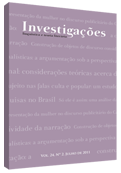Linguagem e responsividade em 'Desenredo'
Abstract
O trabalho analisa o conto Desenredo, de Guimarães Rosa, apresentando uma reflexão sobre a linguagem tendo em vista o processo de representação/criação do mundo e seu caráter axiológico. O objetivo é demonstrar como o conto aponta para questões fundamentais da linguagem humana no que diz respeito ao processo dialógico, revelando a linguagem como possibilidade única de concretização de um sujeito no ato discursivo em que inexoravelmente assume um tom, uma posição e evidencia uma responsividade, uma autoria. Fundamenta-se na perspectiva da análise dialógica do discurso concebida pelo Círculo bakhtiniano apresentando ainda teóricos como Émile Benveniste e outros.References
BAKHTIN, Mikhail. 2010. O autor e a personagem. In: Estética da criação verbal. São Paulo: Martins Fontes.
______; Volochinov. 1988. Marxismo e filosofia da linguagem - Problemas fundamentais do Método Sociológico na Ciência da Linguagem. São Paulo. Hucitec.
BAJTIN, Mijail. 1997. Hacia uma filosofía del acto ético. De los borradores: y otos escritos. Universidad de Puerto Rico.
BENVENISTE, Émile.1988. Problemas de lingüística geral I. Tradução de Maria da Gloria Novak e Maria Luiza Neri. Campinas, SP: Pontes: Ed. da Unicamp.
BRAIT, Beth. 2011. Análise e teoria do discurso. In: Beth Brait (Org.). Bakhtin: outros conceitos-chave. São Paulo: Contexto.
ROSA, João Guimarães.1969. Tutaméia – Terceiras estórias. Rio de Janeiro: José Olympio.
TEZZA, Cristovão. 2003. Entre a prosa e a poesia: Bakhtin e o Formalismo russo. Rio de Janeiro: Rocco.
Downloads
Published
How to Cite
Issue
Section
License
Copyright (c) 2011 Sandra Mara Moraes Lima

This work is licensed under a Creative Commons Attribution 4.0 International License.
Authors who publish with Revista Investigações agree to the following terms:
Authors retain copyright and grant the journal right of first publication with the work simultaneously licensed under the Creative Commons Attribution 4.0 International (CC BY 4.0) license that allows others to share the work with an acknowledgement of the work's authorship and initial publication in this journal.
Authors are able to enter into separate, additional contractual arrangements for the non-exclusive distribution of the journal's published version of the work (e.g., post it to an institutional repository or publish it in a book), with an acknowledgement of its initial publication in this journal.
You are free to:
Share — copy and redistribute the material in any medium or format for any purpose, even commercially.
Adapt — remix, transform, and build upon the material for any purpose, even commercially.
The licensor cannot revoke these freedoms as long as you follow the license terms.
Under the following terms:
Attribution — You must give appropriate credit , provide a link to the license, and indicate if changes were made . You may do so in any reasonable manner, but not in any way that suggests the licensor endorses you or your use.
No additional restrictions — You may not apply legal terms or technological measures that legally restrict others from doing anything the license permits.

